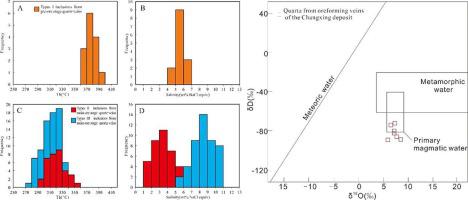当前位置:
X-MOL 学术
›
Ore Geol. Rev.
›
论文详情
Our official English website, www.x-mol.net, welcomes your
feedback! (Note: you will need to create a separate account there.)
Geology, fluid inclusion and H-O-S-Pb isotope constraint on the genesis of the Changxing gold deposit, Fujian, South China
Ore Geology Reviews ( IF 3.2 ) Pub Date : 2021-02-01 , DOI: 10.1016/j.oregeorev.2020.103887 Hui-Xiang Yuan , Pei Ni , Hui Chen , Zhi-Cheng Lv , Xiao-Fei Yu , Tan Bao , Guo-Guang Wang , Rong-Hua Hu , Jian-Wen Du
Ore Geology Reviews ( IF 3.2 ) Pub Date : 2021-02-01 , DOI: 10.1016/j.oregeorev.2020.103887 Hui-Xiang Yuan , Pei Ni , Hui Chen , Zhi-Cheng Lv , Xiao-Fei Yu , Tan Bao , Guo-Guang Wang , Rong-Hua Hu , Jian-Wen Du

|
Abstract The Changxing gold deposit is located in the Wuyi metallogenic belt of South China. Orebodies are primarily hosted in K-feldspar migmatitic granite along the NE- and NNE-striking ductile–brittle fracture structures. The ore minerals mainly include native gold, pyrite, chalcopyrite, whereas the main gangue minerals are quartz, sericite and chlorite. Fluid inclusion studies were conducted on the pre-ore stage quartz veins and main-ore stage quartz veins. Three types of fluid inclusions, namely, CO2-bearing inclusion with smaller carbonic proportion ( 60%) (type II), and aqueous fluid inclusions (type III) can be observed in the quartz. Primary type I inclusions in pre-ore quartz veins show consistent CO2 phase volumetric proportions with homogenization temperatures of 362–396 °C and salinities of 5.0–6.4 wt% NaCl equivalent. The primary coexisting type II and type III inclusions are observed in ore stage quartz vein, sharing similar homogenization temperatures in the range of 292–353 °C and 279–335 °C, but contrasting salinity values at 1.4– 5.3 and 5.3–10.5 wt% NaCl equivalent, respectively. Petrographic observations and microthermometric results collectively show that fluid immiscibility occurred concurrently with gold mineralization during the main-ore stage. The δD (−88.9‰ to −71.8‰) and δ18O (5.9‰ to 8.5‰) of ore-forming fluids imply that the ore-forming fluids were mainly of magmatic origin. The δ34S values (2.1‰ to 4.9‰, with average value of 3.1‰) of the main-ore stage pyrite suggest that sulfur was derived from a homogeneous magmatic source. The lead isotopic compositions suggest that the migmatitization of the K-feldspar granitization granite (206Pb/204Pb = 17.953 to 18.147, 207Pb/204Pb = 15.636 to 15.688, 208Pb/204Pb = 37.727 to 38.851) in the Caledonian had no genetic relationship with gold mineralization of Changxing gold deposit (206Pb/204Pb = 17.466 to 18.157, 207Pb/204Pb = 15.551 to 15.619, 208Pb/204Pb = 37.727 to 38.508), and the Mesozoic magmatic activity likely provided ore materials of Changxing gold deposit. In summary, we propose that the Changxing deposit is a magmatic hydrothermal gold deposit.
中文翻译:

福建长兴金矿床成因地质、流体包裹体及HOS-Pb同位素约束
摘要 长兴金矿床位于华南武夷成矿带。矿体主要位于沿 NE 和 NNE 走向的韧脆断裂结构的钾长石混合花岗岩中。矿石矿物主要有原生金、黄铁矿、黄铜矿,脉石矿物主要有石英、绢云母和绿泥石。对成矿前阶段石英脉和主成矿阶段石英脉进行了流体包裹体研究。石英中可观察到三种流体包裹体,即含碳量较小(60%)的CO2包裹体(II型)和含水流体包裹体(III型)。矿前石英脉中的原生 I 型包裹体显示出一致的 CO2 相体积比例,均质温度为 362-396 °C,盐度为 5.0-6.4 wt% NaCl 当量。在矿石阶段石英脉中观察到主要共存的 II 型和 III 型包裹体,在 292-353 °C 和 279-335 °C 范围内具有相似的均质温度,但盐度值在 1.4-5.3 和 5.3-10.5 wt 之间形成对比% NaCl 当量,分别。岩石学观察和显微测温结果共同表明,在主矿阶段,流体不混溶与金矿化同时发生。成矿流体的δD(-88.9‰~-71.8‰)和δ18O(5.9‰~8.5‰)表明成矿流体主要为岩浆成因。主矿期黄铁矿的δ34S值(2.1‰~4.9‰,平均值为3.1‰)表明硫来源于均质岩浆源。铅同位素组成表明钾长石花岗岩的混合成因(206Pb/204Pb = 17.953~18.147, 207Pb/204Pb = 15.636~15.688, 208Pb/2073Pb = 15.636~15.688, 208Pb/2073Pb = 7~15.8~15.8~18.73P)与金矿的混杂成因关系。长兴金矿床(206Pb/204Pb = 17.466 至 18.157,207Pb/204Pb = 15.551 至 15.619,208Pb/204Pb = 37.727 至 38.508),以及可能提供长生岩中生岩浆活性的金矿床。综上所述,我们认为长兴矿床为岩浆热液金矿床。中生代岩浆活动可能为长兴金矿床提供了矿石原料。综上所述,我们认为长兴矿床为岩浆热液金矿床。中生代岩浆活动可能为长兴金矿床提供了矿石原料。综上所述,我们认为长兴矿床为岩浆热液金矿床。
更新日期:2021-02-01
中文翻译:

福建长兴金矿床成因地质、流体包裹体及HOS-Pb同位素约束
摘要 长兴金矿床位于华南武夷成矿带。矿体主要位于沿 NE 和 NNE 走向的韧脆断裂结构的钾长石混合花岗岩中。矿石矿物主要有原生金、黄铁矿、黄铜矿,脉石矿物主要有石英、绢云母和绿泥石。对成矿前阶段石英脉和主成矿阶段石英脉进行了流体包裹体研究。石英中可观察到三种流体包裹体,即含碳量较小(60%)的CO2包裹体(II型)和含水流体包裹体(III型)。矿前石英脉中的原生 I 型包裹体显示出一致的 CO2 相体积比例,均质温度为 362-396 °C,盐度为 5.0-6.4 wt% NaCl 当量。在矿石阶段石英脉中观察到主要共存的 II 型和 III 型包裹体,在 292-353 °C 和 279-335 °C 范围内具有相似的均质温度,但盐度值在 1.4-5.3 和 5.3-10.5 wt 之间形成对比% NaCl 当量,分别。岩石学观察和显微测温结果共同表明,在主矿阶段,流体不混溶与金矿化同时发生。成矿流体的δD(-88.9‰~-71.8‰)和δ18O(5.9‰~8.5‰)表明成矿流体主要为岩浆成因。主矿期黄铁矿的δ34S值(2.1‰~4.9‰,平均值为3.1‰)表明硫来源于均质岩浆源。铅同位素组成表明钾长石花岗岩的混合成因(206Pb/204Pb = 17.953~18.147, 207Pb/204Pb = 15.636~15.688, 208Pb/2073Pb = 15.636~15.688, 208Pb/2073Pb = 7~15.8~15.8~18.73P)与金矿的混杂成因关系。长兴金矿床(206Pb/204Pb = 17.466 至 18.157,207Pb/204Pb = 15.551 至 15.619,208Pb/204Pb = 37.727 至 38.508),以及可能提供长生岩中生岩浆活性的金矿床。综上所述,我们认为长兴矿床为岩浆热液金矿床。中生代岩浆活动可能为长兴金矿床提供了矿石原料。综上所述,我们认为长兴矿床为岩浆热液金矿床。中生代岩浆活动可能为长兴金矿床提供了矿石原料。综上所述,我们认为长兴矿床为岩浆热液金矿床。











































 京公网安备 11010802027423号
京公网安备 11010802027423号